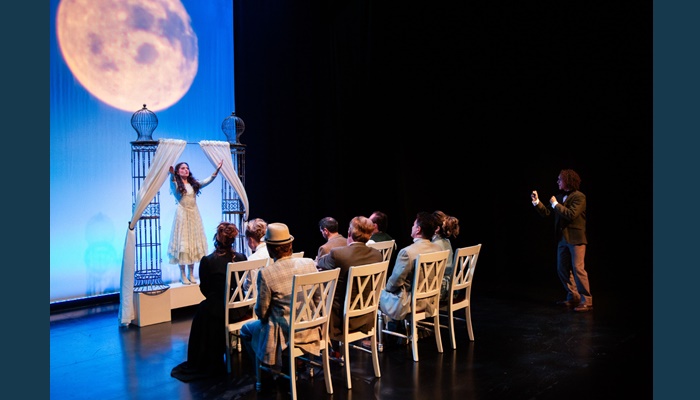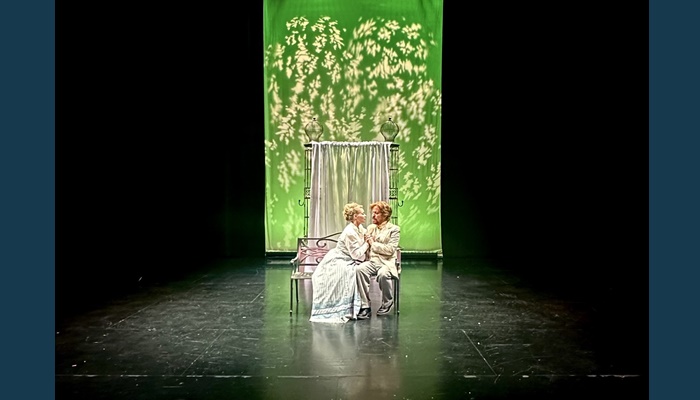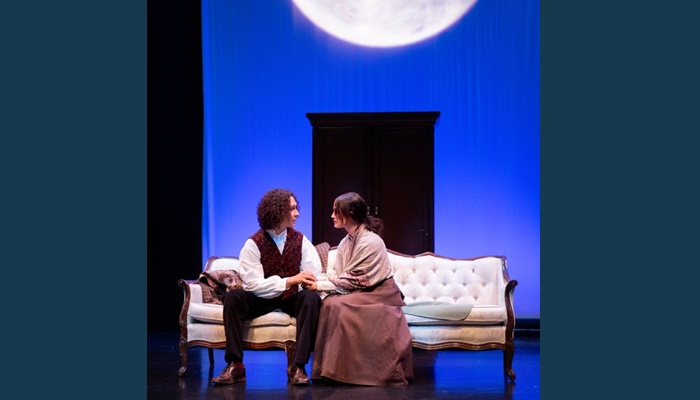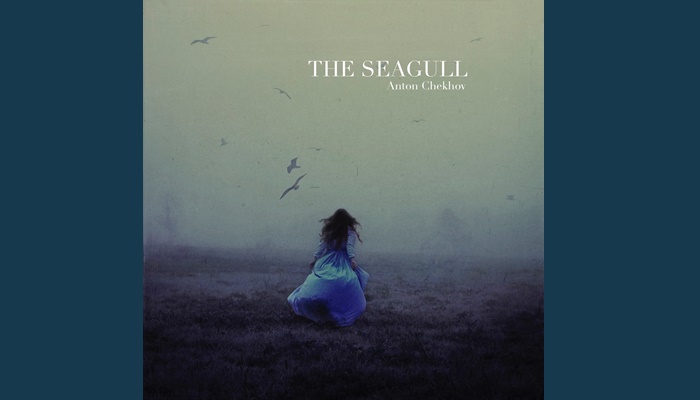SALT LAKE CITY, Utah, Sept. 20, 2024 (Gephardt Daily) — I am not sure I should admit this, but I managed to get through the whole of my school and university training in theater without ever studying, or seeing, “The Seagull,” or, for that matter, any other Anton Chekhov play. Plebeian, I know.
So I came into this latest production from Sting and Honey Company with no particular expectation of what the show should or could be. The aim of the company, its website says, is to produce a body of work that includes classical and contemporary plays, new works, and educational outreach. It has produced classics by authors such as William Shakespeare, Samuel Beckett, Eugene O’Neill, Peter Shaffer, and Henrik Ibsen. It has also presented adaptations of fairy tales, including “Snow White,” “Sleeping Beauty’s Dream” and “Cinderella,” written by the company’s artistic director Javen Tanner. In addition, he wrote the company’s annual Christmas show, “This Bird of Dawning.”
I am absolutely in favor of this mission, particularly because the classics are not produced often enough here, I believe. “The Seagull,” which was written in 1895 and first produced in 1896, is generally considered to be the first of the Russian playwright’s four major plays. Like Chekhov’s other full-length works, “The Seagull” relies upon an ensemble of diverse, fully developed characters; 11 in total. The playwright described the piece in a letter written in October 1895: “I am writing a play which I shall probably not finish before the end of November. I am writing it not without pleasure, though I swear fearfully at the conventions of the stage. It’s a comedy, there are three women’s parts, six men’s, four acts, landscapes (view over a lake); a great deal of conversation about literature, little action, and tons of love.”
Chekhov must have added a couple of characters after writing the letter, and he’s right, there is indeed TONS of love. This bittersweet tragi-comedy primarily dramatizes the romantic and artistic conflicts between four central characters who have gathered at an estate on the shore of a lake. They are the dissolute but popular writer Boris Trigorin, the ingenue Nina Zarechnaya, the charismatic, middle-aged actress Irina Arkadina, and her melancholy, frustrated son, the symbolist playwright Konstantin Treplev. Konstantin is lovesick over Nina, while Nina, enchanted by the debonair Trigorin and obsessed with acting on the stage, follows Trigorin (who is also Irina’s lover) to the city, then returns. The other characters also have dramatic love lives; schoolteacher Semyon Medvedenko loves Masha, the daughter of the estate’s steward Ilya Shamrayev and his wife Polina Andreyevna. However, Masha is in love with Konstantin, and Polina is having an affair with Yevgeny Dorn, a doctor. The play has more twists and turns than a daytime soap opera!

“The Seagull” was first translated into English for a performance at the Royalty Theatre, Glasgow, in 1909. Since that time, there have been numerous translations of the text; between 1998 and 2004 alone there were 25 published versions. This iteration was translated by the prolific playwright Tom Stoppard (who, by the way, was born in Czechoslovakia and went to Britain as a refugee) for the Peter Hall Company at the Old Vic in London in 1997. Its United States premiere in July 2001 in New York City drew crowds who sometimes waited 15 hours for tickets.
This version of “The Seagull,” which is directed by Tanner, opened Friday, Sept. 13, and goes until Saturday, Sept. 28, at the Regent Street Black Box at the Eccles Theater downtown. There are shows on Thursday, Friday and Saturday at 7:30 p.m., with matinees on Saturday at 2 p.m. Tickets are available here.
Every element of this production, to me, was highly successful. Tanner’s direction is spare, clean, and lean, but at the same time, muscular and brave, with not a beat dropped or a moment glossed over. Every actor’s performance is intentional and well-thought-out, but never overplayed. The ensemble work is excellent, with no one pulling focus, and everyone listening intently.
The women of the show, you could say, mostly have more dramatic arcs than their male counterparts, certainly with more comedic moments, and each is brilliantly cast. Deena Marie Manzanares as Irina is regal, charismatic and as multi-layered as her elegant ensembles, while Suni Gigliotti, who is one of Salt Lake’s most versatile actors, is wonderfully angsty as the original Goth-girl Masha, with her all-black outfits (she says she is “in mourning for her life” at the age of 22), ebony sunglasses and a proclivity for snorting snuff and chugging vodka. Krisha Deaver turns in an earthy, grounded performance as Polina, Masha’s mother.

The men of the show are perhaps even more angsty; Tanner does double duty both as director and as Trigorin, who is considered one of Chekhov’s greatest male roles. Trigorin is a fairly unlikeable character; when he sees the Seagull that Konstantin has shot as a token of love for Nina, he coldly muses on how he could use it as a subject for a short story. “The plot for the short story: a young girl lives all her life on the shore of a lake. She loves the lake, like a gull, and she’s happy and free, like a gull. But a man arrives by chance, and when he sees her, he destroys her, out of sheer boredom. Like this gull.” Tanner has a great knack for giving the characters he plays a sort of gentleness, as if we are seeing their soft, vulnerable underbelly as well as their posturing exterior. As Konstantin, Trayven Call is beautifully understated and intense, while Bijan Hosseini (who also assistant directed) adds some comic relief as the bumbling manager of the estate. Alvaro Cortez, Stephen Williams, Cam Deaver and Will Mortenson also turn in solid performances.
The heart and soul of the show is, without doubt, Ryann Bailey’s Nina. It is a large role, with a massive arc, and has been played by actresses including Natalie Portman, Carey Mulligan, Laura Linney, Emilia Clarke and Romola Garai. Bailey turns in a superlative performance as we see her devolve from the luminous, vulnerable girl who just wants to act and be famous, to the broken, brittle, deconstructed woman we encounter at the end of the play. Her monologue in the closing scene is one of the most-performed by young actors across the world (the friend I was seeing the show with told me she has done it maybe 10 times in different forms throughout her career), but it’s also tough to nail, and Bailey does it flawlessly. My heart broke for Nina as she repeatedly compares herself to the gull that Konstantin killed, then rejects that and reminds herself: “I am an actress.”
The production values are simple, but striking in their stark boldness. The set, also by the very hardworking Tanner, consists primarily of a large cloth backdrop at the back of the stage, onto which a different vivid hue and an image is projected for each act; for the first, it is blue, with a huge moon, for the second, it is green, with some kind of forest-like foliage, for the third, it is orange, with a window, then for the last, it is blue with the moon again. The set itself consists primarily of chairs, tables, sofas and desks that are brought on and off, and Tanner cleverly utilizes the set pieces, at times placing characters facing upstage, which is an interesting and inventive choice. The lighting, by Aubree Schuck, is as striking as the set, with washes of various colors that do not change a great deal, which puts further emphasis on the performances. The costumes, by Ashlee Fawcett, are true to the period and absolutely stunning, with great attention to detail, but not fussy, still allowing the actors to move easily.

To me, the play is about yearning for what you don’t have. Every stage of life is represented, and every character is yearning — Nina to be famous, Konstantin to be respected, Trigorin to feel something, and Irina to remain at the center of a world that may be moving on without her. For his director’s note, Tanner has selected Sylvia Plath’s “Mad Girl’s Love Song,” a poem that perfectly parallels the play. It contains a line that is repeated: “I think I made you up inside my head.” In a sense, that sums up the world we see in “The Seagull,” which explores both how people perceive themselves and the persona they create, as well as the way the characters make those they fall in love with into mythical beings, so that when their actual selves are revealed, disappointment is inevitable.
For more information and for tickets to “The Seagull,” click here.








